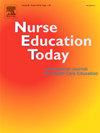Development and evaluation of animated instructional materials and collaborative learning for nursing research courses: An action research study
IF 4.2
2区 医学
Q1 EDUCATION, SCIENTIFIC DISCIPLINES
引用次数: 0
Abstract
Background
Nursing research courses can be challenging due to the complex terminology, causing some undergraduates to be overwhelmed and have low motivation to engage in the course content. Theory-based animated instructional materials can enhance students' interest and learning outcomes, potentially becoming an effective teaching strategy for nursing research courses.
Aims
To develop animated instructional materials based on the cognitive theory of multimedia learning and four-component instructional design model, integrate collaborative learning strategies, and evaluate students' cognitive load and learning experiences.
Design
Action research approach.
Setting
A university in central Taiwan.
Participants
Fifty-one undergraduate nursing students.
Methods
Six lessons comprising 17 animated instructional materials were developed. The course structure includes three phases: (1) preclass (students watch animated videos on the teaching platform), (2) in-class (students engage in collaborative learning groups [8–9 members] to discuss, complete tasks, and present, with teachers providing clarifications), and (3) postclass (students perform reflective writing and participate in learning assessments, including cognitive load and satisfaction surveys).
Results
Students reported a moderate level of intrinsic cognitive load (M = 1.94; standard deviations [SD] = 0.92; range 1.71–2.45) and a low level of extraneous cognitive load (M = 1.49; SD = 0.71; range 1.47–1.53) based on a five-point scale, indicating that the materials imposed minimal extraneous load. Meanwhile, overall satisfaction was high (M = 4.39; SD = 0.62; range 4.33–4.43) based on a five-point scale, with improvement in learning skills and critical thinking/problem-solving abilities rated the highest. The qualitative reflections revealed five themes: (1) engaging and stress-reducing learning experience, (2) simplifying concepts to improve memory, (3) complex concept interpretation advantage, (4) convenience for preview and review, and (5) collaborative learning benefits and challenges.
Conclusions
Theory-based animated instructional materials can enhance students' learning satisfaction and comprehension without additional cognitive load. Collaborative learning was beneficial. However, effective implementation requires careful monitoring of group dynamics and timely conflict resolution.
护理研究课程中动画教学材料与合作学习的发展与评估:一项行动研究
护理研究课程因其复杂的术语而具有挑战性,导致一些本科生不知所措,缺乏参与课程内容的动力。基于理论的动画教学材料可以提高学生的学习兴趣和学习成果,有可能成为护理研究课程的有效教学策略。目的基于多媒体学习认知理论和四要素教学设计模型开发动画教材,整合协作学习策略,评估学生的认知负荷和学习体验。设计行动研究方法。位于台湾中部的一所大学。研究对象:护理专业本科生51名。方法编制了6节课共17部动画教材。课程结构包括三个阶段:(1)课前(学生在教学平台上观看动画视频),(2)课中(学生组成协作学习小组[8-9人]讨论、完成任务、陈述,由教师进行说明),(3)课后(学生进行反思性写作,参与学习评估,包括认知负荷和满意度调查)。结果学生的内在认知负荷为中等水平(M = 1.94,标准差[SD] = 0.92,范围1.71-2.45),外在认知负荷为低水平(M = 1.49,标准差[SD] = 0.71,范围1.47-1.53)。同时,根据五分制,整体满意度较高(M = 4.39; SD = 0.62;范围4.33-4.43),其中学习技能和批判性思维/解决问题能力的提高得分最高。定性反思揭示了五个主题:(1)参与和减轻压力的学习体验,(2)简化概念以提高记忆,(3)复杂概念解释优势,(4)预习和复习的便利,以及(5)协作学习的好处和挑战。结论基于理论的动画教材能在不增加认知负荷的情况下提高学生的学习满意度和理解力。协作学习是有益的。然而,有效的实施需要仔细监测群体动态和及时解决冲突。
本文章由计算机程序翻译,如有差异,请以英文原文为准。
求助全文
约1分钟内获得全文
求助全文
来源期刊

Nurse Education Today
医学-护理
CiteScore
6.90
自引率
12.80%
发文量
349
审稿时长
58 days
期刊介绍:
Nurse Education Today is the leading international journal providing a forum for the publication of high quality original research, review and debate in the discussion of nursing, midwifery and interprofessional health care education, publishing papers which contribute to the advancement of educational theory and pedagogy that support the evidence-based practice for educationalists worldwide. The journal stimulates and values critical scholarly debate on issues that have strategic relevance for leaders of health care education.
The journal publishes the highest quality scholarly contributions reflecting the diversity of people, health and education systems worldwide, by publishing research that employs rigorous methodology as well as by publishing papers that highlight the theoretical underpinnings of education and systems globally. The journal will publish papers that show depth, rigour, originality and high standards of presentation, in particular, work that is original, analytical and constructively critical of both previous work and current initiatives.
Authors are invited to submit original research, systematic and scholarly reviews, and critical papers which will stimulate debate on research, policy, theory or philosophy of nursing and related health care education, and which will meet and develop the journal''s high academic and ethical standards.
 求助内容:
求助内容: 应助结果提醒方式:
应助结果提醒方式:


